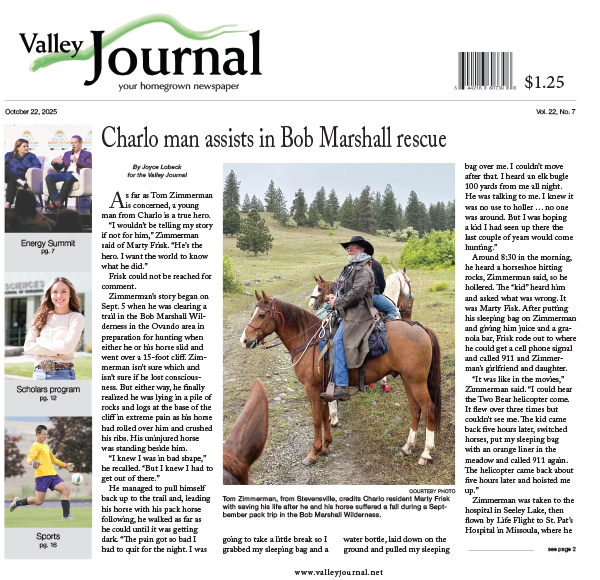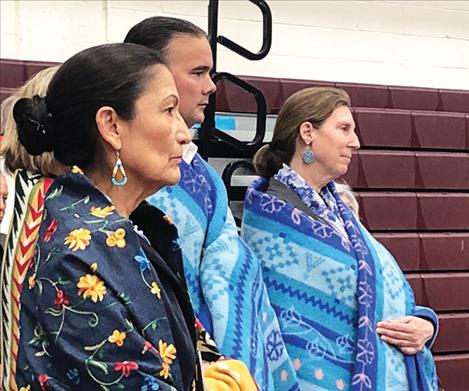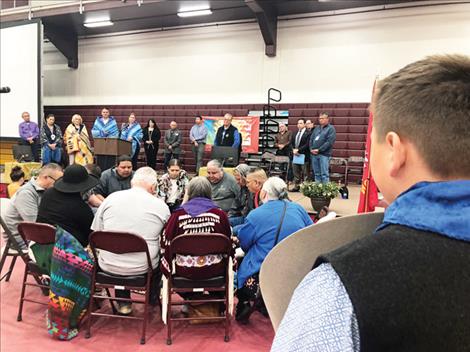U.S. Secretary of Interior visits Bison Range
Hey savvy news reader! Thanks for choosing local.
You are now reading
2 of 3 free articles.
CHARLO — U.S. Secretary of the Interior Deb Haaland, the nation’s first Native American cabinet member, was on hand Saturday for the culmination of a vibrant three-day celebration of the restoration of the Bison Range to tribal ownership.
“Today represents a return to something pure and sacred,” she said.
Tom McDonald, chairman of the Confederated Salish and Kootenai Tribes, introduced Haaland as “my hero.” He told the large crowd assembled at the Salish Kootenai College gym, “the presence of the first Native American woman Secretary of the Interior elicits emotions in all of us I cannot put into words.”
Haaland was equally emotional when she took the stage, declaring it “a tremendous honor to spend the day with so many of you – tribal leaders, water leaders, environmental leaders, women leaders.”
She spoke of her impressions of the reservation, and said, “I can’t help but imagine what it looked like … when our indigenous ancestors lived on this land alongside a plethora of animals and they each respected their place in the balance of nature, relying on them for food and subsistence and with the belief future generations would also rely upon that important relationship.”
“We all know that history took a tragic and lethal turn,” she added. “But we are still here, you are still here.”
She saluted the years of hard work, commitment, and vision that led to this monumental occasion.
“The return of the Bison Range to these tribes is a triumph and a testament to what can happen when we collaboratively work together to restore balance to ecosystems that were damaged by greed and disrespect,” she told the audience.
In his remarks, McDonald recounted the long journey, beginning with Little Prairie Falcon Robe, who escorted a few orphaned bison calves across the Continental Divide to the Flathead Reservation in the 1870s. He described how those calves flourished and became the foundation of a large herd, owned by Charles Allard and Michel Pablo, that roamed freely along the lower Flathead River.
With the Allotment Act of 1904, the federal government began to systematically dismantle the reservation that had been given to the Tribes in the Hellgate Treaty of 1855, in exchange for relinquishing their vast aboriginal territories. As homesteaders arrived the herd was sold, only to be repurchased when the government decided to establish the National Bison Range in 1908 on tribal land – without tribal consent and paying a fraction of its value.
McDonald called the Bison Range a gift for the Tribes to “protect and care for and pass on to future generations.”
He also invited audience members who had a hand in the restoration to stand, beginning with descendants of Prairie Falcon Robe, Michel Pablo and Charles Allard, and continuing to include tribal employees, those who worked for the Department of the Interior and the Fish and Wildlife Service, partners in state government, and representatives of Montana’s congressional delegation.
Also acknowledging “hundreds of others who were not able to be here with us,” he said, “Without you this would not have happened.”
People worked tirelessly, he added, “because they wanted to restore what was lost.”
Lt. Gov. Kristen Juras was also on hand. A former law professor at the University of Montana, she remembered dissecting the Hellgate Treaty with students to help illustrate the foundation of property law in Montana. “It gave us a deep understanding of your tribes’ history and it makes it so meaningful to me and such a privilege to share, to attend this day of rejoicing,” she said.
“We acknowledge and affirm the cultural, spiritual, ceremonial life-giving significance of buffalo to the Salish, Kootenai and Pend d’Oreille people and all Native Americans – a relationship that existed since time immemorial.”
Juras also pointed out that a young man herded those calves across the mountains and urged young people in the audience “to never underestimate the impact that a single person can have on their people, their community and their future generations. That herd became seed stock for virtually every bison preserve in North America. We would not be here to celebrate today but for the vision and courage of your ancestors.”
In addition to Juras and Haaland, dignitaries included Martha Williams, director of the U.S. Fish and Wildlife Service and former head of Montana’s wildlife agency, and Brian Newland, Assistant Secretary for Indian Affairs. A group of school children gave Haaland a lovely beaded shawl, while the other three were draped in Pendleton blankets.
The celebration opened with a prayer by Salish elder Johnny Arlee, and included a presentation by the Mission Valley Honor Guard, songs by two drum groups, and closing comments by former tribal chairman and Kootenai elder Vernon Finley.
During his opening prayer and talk, Arlee spoke of tribal efforts to reclaim language and traditions. “I’m seeing a future that’s coming back … the spirits saved us from destruction, helped us find our roots and hang on and be proud of who we are.”
Haaland also spoke to renewed hope. “I’m confident the future is bright for those little calves just learning to walk this spring and for the generations of CSKT members who will be reconnected with our ancestral traditions over the decades,” she said.
“Our country is better when we work together, and communities thrive when we have respect for nature and all it has to offer us.”


















